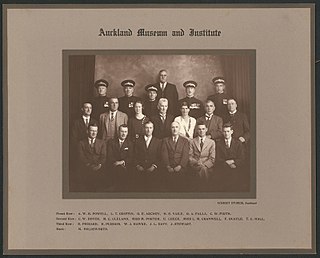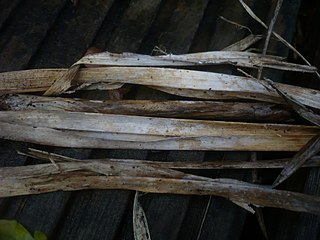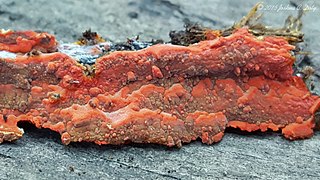
Dacrycarpus dacrydioides, commonly known as kahikatea and white pine, is a coniferous tree endemic to New Zealand. A podocarp, it is New Zealand's tallest tree, gaining heights of 60 m over a life span of 600 years. It was first described botanically by the French botanist Achille Richard in 1832 as Podocarpusdacrydioides, and was given its current binomial name Dacrycarpus dacrydioides in 1969 by the American botanist David de Laubenfels. Analysis of DNA has confirmed its evolutionary relationship with other species in the genera Dacrycarpus and Dacrydium.

The Polyporaceae are a family of poroid fungi belonging to the Basidiomycota. The flesh of their fruit bodies varies from soft to very tough. Most members of this family have their hymenium in vertical pores on the underside of the caps, but some of them have gills or gill-like structures. Many species are brackets, but others have a definite stipe – for example, Polyporus badius.

Lewis David de Schweinitz was a German-American botanist and mycologist from Bethlehem, Pennsylvania. Considered the "Father of North American Mycology," he also made significant contributions to botany.

Arthur William Baden Powell was a New Zealand malacologist, naturalist and palaeontologist, a major influence in the study and classification of New Zealand molluscs through much of the 20th century. He was known to his friends and family by his third name, "Baden".

Rhytisma vitis is a species of fungus in the family Rhytismataceae. It was described by Lewis David de Schweinitz in 1832.
Aleurocystis is a genus of fungi in the Stereaceae family. The widely distributed genus contains three species. Aleurocystis was circumscribed by the New Zealand-based mycologist Gordon Herriot Cunningham in 1956.

Epithele is a genus of crust fungi in the family Polyporaceae.

Lopharia is a genus of fungi in the family Polyporaceae. The genus was circumscribed by Károly Kalchbrenner and Peter MacOwan in 1881.

Alexander Carter Graham (1881–1957) and Peter Graham (1878–1961) were mountaineers, guides and hotel operators in New Zealand. They were instrumental in the establishment of the early New Zealand tourist industry and earned themselves worldwide reputations as climbers and guides.

Boletinellus merulioides, commonly known as the ash-tree bolete, is a species of bolete fungus in the family Boletinellaceae. Described as new to science in 1832, it is found in Asia and eastern North America, where it grows on the ground near ash trees.

Picipes badius, commonly known as the black-footed polypore or black-leg, is a species of fungus in the family Polyporaceae. It causes a white rot of hardwoods and conifers. The species is found in temperate areas of Asia, Australia, Europe, and North America. It has a dark brown or reddish-brown cap that reaches a diameter of 25 cm (9.8 in), and a stipe that is often completely black or brown at the top and black at the base.

Phlebia incarnata is a species of polypore fungus in the family Meruliaceae. It is inedible.
Robert Francis Ross McNabb was a New Zealand mycologist. He was born in Kawakawa, and attended local schools in his youth, including Whangarei Boys' High School and Southland Boys' High School. He received a BSc degree from the University of Otago in 1956, and two years later an MSc for his work on mycorrhizae morphology in native New Zealand plants. In 1961, having been awarded a National Research Fellowship the year before, McNabb left New Zealand for the UK to study with Cecil Terence Ingold at Birkbeck College. McNabb earned a PhD in 1963; his thesis was titled "Taxonomic studies in the Dacrymycetaceae". He was jointly awarded the Hamilton Memorial Prize in 1966 from The Royal Society of New Zealand, the same year he was appointed to the editorial board of the New Zealand Journal of Botany. Most of McNabb's later publications, largely published in this journal, were about fungal taxonomy. Fungus species named in honor of McNabb include Paxillus mcnabbii, and Entoloma mcnabbianum.

Sarcodon thwaitesii is a species of tooth fungus in the family Bankeraceae. It is found in Asia, Europe, and New Zealand, where it fruits on the ground in mixed forest.

Polyporus radicatus is a species of fungus in the family Polyporaceae. It was described as new to science by German-American botanist Lewis David de Schweinitz in 1832. It is found in North America, including Mexico. It grows on the ground, probably from buried roots or originating from sclerotia. Its spores are more or less ellipsoid to spindle shaped, measuring 12–15 by 6–8 μm. It is inedible.

Phlebia coccineofulva, commonly known as the scarlet waxcrust, is a species of crust fungus in the family Meruliaceae. It was described as a new species by Lewis David de Schweinitz in 1832. The fungus is found in North America, continental Europe, and northern Asia, where it grows as a saprophyte on decaying stumps and woody forest debris.

Datroniella scutellata is a species of fungus in the family Polyporaceae, and the type species of genus Datroniella.

Diderma effusum is a species of slime mould in the family Didymiaceae, first described by Lewis David de Schweinitz in 1832 as Physarum effusum, and transferred to the genus, Diderma, in 1894 by Andrew Price Morgan. It is found throughout the world, It feeds on nonliving organic matter.
















